How to patent an antibody
Charles Craik knows a lot about patenting research findings.
The University of California, San Francisco, professor of pharmaceutical chemistry and protease expert is named as an inventor on 16 patents with six under review, most recently a series of antibodies targeting the urokinase-type plasminogen activator receptor pathway to both image and treat aggressive and recurring cancers. He also has taught in a course involving intellectual property at UCSF for several years. Craik sat down with ASBMB Today writer Laurel Oldach to talk about Amgen Inc. v. Sanofi et al., a lawsuit over antibody patents that has generated a lot of buzz in biotechnology. Their conversation has been edited for length and clarity.
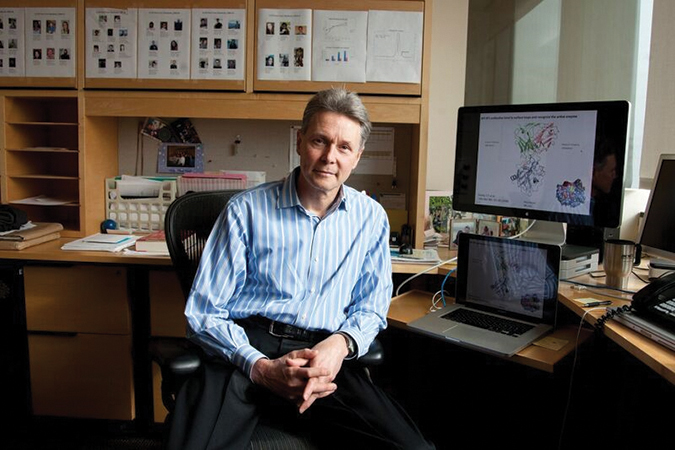 Charly Craik, pictured here in his office at the University of California, San Francisco, says he enjoys figuring out how to protect an invention “so someone can make money off it and the cycle can continue." Cindy Chew/UCSF
Charly Craik, pictured here in his office at the University of California, San Francisco, says he enjoys figuring out how to protect an invention “so someone can make money off it and the cycle can continue." Cindy Chew/UCSF
Do you think a lot about patents and patenting?
I definitely think about it a lot. I’m an academic professor, so that’s my job 100 percent of the time. But in my spare time, I have started companies, and I’ve learned certain things in the lab that have been very practical. I’m still learning. Perhaps more than an average person, I think about the practical applications of my work.
As an assistant professor, I helped validate HIV proteaseas a therapeutic target in 1990. I don’t have the patent on HIV protease — we got the crystal structure, and we made it available — but I did work with companies so they could develop compounds that could target the enzyme and provide the basis for making a pharmaceutical.
I definitely believe that it’s good to patent things, because in my opinion, if pharmaceutical companies are going to invest their money in developing a drug, they need to have it protected so they can try to recoup some of those costs.
I don’t think everything should be patented, and I don’t spend all my time just thinking about patents, but when there is something that can be a practical invention, I enjoy going through the process of figuring out how to get it protected so someone can make money off it and the cycle can continue for the development of future drugs.
And I’ve been told multiple times by companies, big and small, “If you don’t get a patent, Charly, we will not be able to work with you.”
Of all of the monoclonal antibodies patented last year, about a quarter came out of academic research institutions. A large subset of those worked with a commercial co-applicant. How does that process work?
It’s very hard to make one generalization about the whole process. But imagine yourself running a lab. You’re in a university; you’re making discoveries. You’re pushing the edge of the field, really trying to do something completely novel that no one’s ever thought of or done before. That’s what drives us.
If you come across something that could be of practical interest, one of the first things you usually do is file a disclosure. A disclosure means going to your university and saying, “I think I have something that’s of value here.” You write down the information associated with why you think it’s valuable, what the concept is, when the experiments occurred that reduced it to practice — that really showed that it happened. That’s filing a disclosure. It doesn’t cost anything, just filling out a form. But it puts it on record at the university.
The university evaluates whether it’s worth filing a patent. Now, it costs money to file a patent. Depending on the lawyer, it can be very inexpensive and not very good, or it can cost between $10,000 and $15,000. Let’s say it’s roughly that amount of money. If every university filed on every idea, they’d break the bank really fast. So there’s an evaluation process.
As a professor, particularly in a university that doesn’t have a company behind it, these filings can really drain the bank. The hope is there will be some big winners and there’ll be a jackpot, and that supports the whole thing. But it can be pretty risky.
So the cost is for a lawyer to make the patent watertight?
That’s a way to put it. But it is a judgment call — no one knows exactly how to write a patent. In the Sanofi-Amgen case, there were highly qualified lawyers. In one case, you could say that he or she failed. On the other hand, the patent was upheld. So it’s divining tea leaves in some cases.
When a lawyer talks to you, they’re charging by the hour; if they write stuff up, they charge you for that. I’ve got ways of keeping those costs down: I write a lot of the stuff myself, and they turn it into legalese; that saves a huge amount of time. If I’m about to publish something, a lot of it is already written.
The university has to decide whether they’re going to pay those costs. Sometimes they say, “Well, we don’t think this is of interest; can you do some more work?” or they go out and market it, speaking in very vague terms. They can say, “We have a potential cure for cancer,” and they haven’t told anything. Or they say, “We’ve targeted this particular pathway, and we’ve found this particular enzyme,” and that’s still not giving a whole lot away.
Companies will sometimes reach out to the university and say, “Oh, we’re interested in this area; we’ll sign a confidentiality disclosure agreement.” And now the researcher is allowed to go and talk to that company.
Sometimes a company is just gathering information. They have no intention of ever licensing your patent. As you get into this, you can smell that pretty quickly. If they’re genuinely interested, they might say, ‘OK, we’ll co-develop this with you.” If it was all done at the university, they say, “We’ll license it.” There are lots of ways. But that disclosure is the beginning.
 The first five claims from a patent Craik and two colleagues filed in 2010 describe their invention of antibodies that bind to urokinase-type plasminogen activator receptor, blocking its interaction with integrins. This application listed 39 claims in total. Courtesy of Charles Craik
The first five claims from a patent Craik and two colleagues filed in 2010 describe their invention of antibodies that bind to urokinase-type plasminogen activator receptor, blocking its interaction with integrins. This application listed 39 claims in total. Courtesy of Charles Craik
Do you wish someone had told you about the patent process when you were starting out?
I was fortunate enough to have exactly that. When I was an assistant professor, when we had HIV protease, a lawyer worked with us. He and I got along really well, and he taught me a lot off the clock about how to write a good patent. He took the time to teach me 30 years of his life in a few weekends.
That was extremely valuable. So I started a course at UCSF to introduce students to the process of intellectual property and how to develop their ideas beyond publishing important papers. If they want to start a company, what are the fundamental points about the whole process? I bring in experts to teach that sort of thing.
If you’ve ever seen a patent, it can be 15 pages. It can be 60 pages. It’s an intimidating document. The language is somewhere between Shakespeare and science, and it’s just not easy reading.
Not to say that all that prose isn’t important, but to keep things simple, go straight to the claims. They are the essence of the patent. And the claims are also prioritized. The No. 1 claim is the most important thing to read. If you’re writing a patent, make sure that first claim is really substantive. Everything flows from there.
It’s like trying to write a research paper. I teach my students to focus on the data. Just tell me what the story is on the data, and then the paper is going to come. It’s the same on a patent. Get your claims.
You’ve applied for a lot of patents, and a good number have been awarded or licensed out and are in commercial development. What’s the ratio of hits to misses?
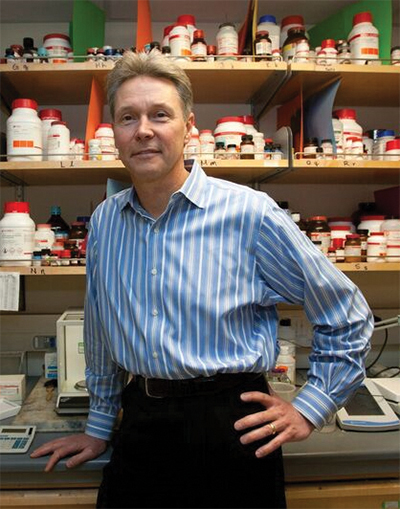 Charly Craik, pictured here in his lab at University of California, San Francisco, worked early in his career with an attorney who taught him how to write a good patent. “He took the time to teach me 30 years of his life in a few weekends,” Craik said. Cindy Chew/UCSF
Charly Craik, pictured here in his lab at University of California, San Francisco, worked early in his career with an attorney who taught him how to write a good patent. “He took the time to teach me 30 years of his life in a few weekends,” Craik said. Cindy Chew/UCSF
That’s hard to generalize. Sometimes I think if I were better, they’d all be licensed out. That’s always the thought that haunts you as a scientist: “God, I wish I were better at this.”
I think I’ve gotten better as time goes on. At the very beginning, HIV protease was a pretty big hit. But like I said, we initially published that freely. We did file for some inhibitors, but it’s the job of pharmaceutical companies to make drugs. So once they had the target, it was a free-for-all; they were off and running. My lab was academic; we had a few chemists making some molecules compared to 350 chemists at Merck. And Merck developed some good inhibitors.
So back to your question; maybe 10 percent of the things we file disclosures on actually make it into a patent that’s then awarded, that then is licensed out.
And then is perhaps considered for development?
Yes. And it’s sometimes said that a patent is only as good as its ability to be defended.
Some patents never are contested. A lot of money can be made from them, and they run out before there’s a problem. But usually, if a patent is effective, valid, licensed and valuable, when it starts making money it’s going to be tested.
That’s exactly what happened in Amgen v. Sanofi. Statins were going off patent, and so this whole market was wide open for something new. This PCSK9 antibody potentially could keep your cholesterol levels below what a statin could, particularly for people who aren’t responsive to statins, and this was a pretty cool thing. There was a big race, and a lot of money was involved that drove some exciting new science.
What do you think about the appeals court’s decision in the Amgen v. Sanofi case — that knowing about a newly characterized antigen is not enough to give an inventor a patent on a whole class of antibodies that bind to it?
I have to choose my words on this one.
I find it very disappointing that this is the direction patents are going with antibodies, because it’s slicing the salami so thin that you can’t get a meal off of it. So that’s a disappointment.
In the law, it always comes down to a particular unique situation. But you still want the broad claims.
For example, I tried in the 1990s to get a patent for an antibody inhibiting any protease. No one had done it, no one had filed; there were no examples where an antibody could trap a protease in its active state versus an inactive state. It was a big idea, right? The examiner came back and said, “No. Too broad.” And in the end they gave me any antibody that would inhibit this particular protease. That was a disappointment.
But now, reading this Amgen v. Sanofi case, I wouldn’t even get that. They would only give me that particular antibody inhibiting that particular protease, just like PCSK9. That’s all you’re getting: just one particular antibody. So if someone gets another antibody with a different sequence, it’s not protected.
The pendulum swings, and in my opinion it’s getting too specific. To have any value to a patent, so that someone would go through the whole process, it should cover more space.
You sound pessimistic.
I don’t think this is the end of getting good patents in the antibody space. There’s still a lot of meat on those bones.
There are so many opportunities in the antibody space right now; immunotherapy has taken over, but you can do other things with antibodies. They can translate into the clinic as diagnostics, as imaging agents, as therapeutics at the margins of tumor environment, and the list goes on and on and on.
I can’t say Amgen v. Sanofi is just a speed bump, but the road isn’t completely washed out. We just have to figure out how to navigate around it.
Enjoy reading ASBMB Today?
Become a member to receive the print edition four times a year and the digital edition monthly.
Learn moreGet the latest from ASBMB Today
Enter your email address, and we’ll send you a weekly email with recent articles, interviews and more.
Latest in Industry
Industry highlights or most popular articles

How Alixorexton could transform narcolepsy treatment
A new investigational drug, alixorexton, targets the brain’s orexin system to restore wakefulness in people with narcolepsy type 1. Alkermes chemist Brian Raymer shares how molecular modeling turned a lab idea into a promising phase 3 therapy.

Inside industry postdocs
As more Ph.D. scientists look beyond academia, industry postdocs offer a new kind of training, where mentorship meets mission-driven research. Fellows at Pfizer and Genentech share how these programs prepare them to translate discovery into impact.
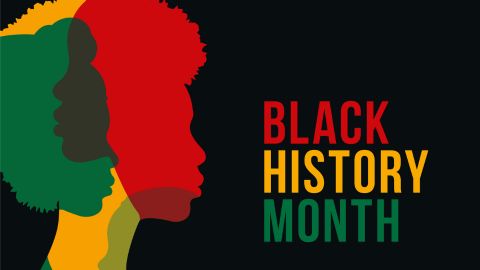
Black excellence in biotech: Shaping the future of an industry
This Black History Month, we highlight the impact of DEI initiatives, trailblazing scientists and industry leaders working to create a more inclusive and scientific community. Discover how you can be part of the movement.
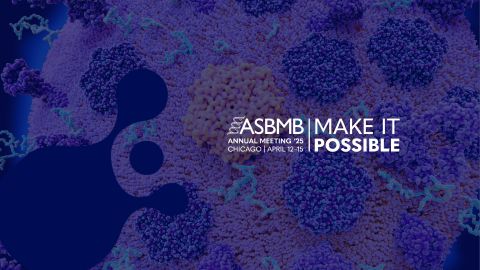
Attend ASBMB’s career and education fair
Attending the ASBMB career and education fair is a great way to explore new opportunities, make valuable connections and gain insights into potential career paths.
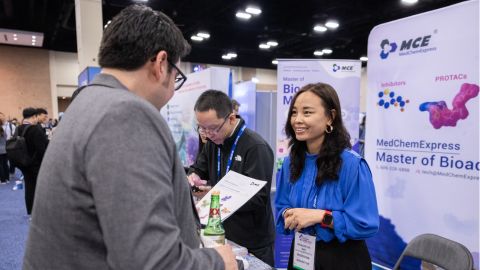
Benefits of attending a large scientific conference
Researchers have a lot of choices when it comes to conferences and symposia. A large conference like the ASBMB Annual Meeting offers myriad opportunities, such as poster sessions, top research talks, social events, workshops, vendor booths and more.
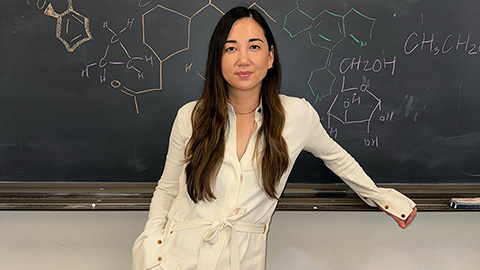
Biotech startup worms its way into therapeutics
Andrea Choe's company, Holoclara, has created an anti-inflammatory drug based on a molecule from worms.

